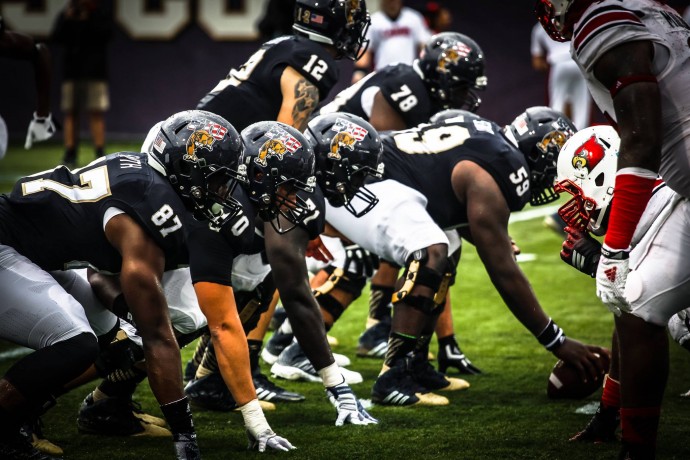Brian Olmo | Summer 2023 Sports Director
Andrea Loizidou is a mathematics master’s student and track runner at FIU. She’s from Cyprus – a country just south of Turkey, 6,393 miles from Miami.
The track she runs on is a lot closer, but it’s still a journey to get there.
Despite being the second-largest sport at FIU by participation, men’s and women’s track and field don’t have their own track to practice on campus.
Instead, members of both teams have to commute to Tropical Park, about four miles south of the Modesto Maidique Campus.
It’s one of many issues athletic director Scott Carr hopes to fix — in the meantime, though, athletes spoke to PantherNOW about the difficulties these problems create.
Leonarda Farkas, a senior marketing student and a member of both cross country and track and field, described the off-campus trek.
“When we have workouts that actually require a track, we drive to Tropical Park, which is a public track. And that’s also really complicated because sometimes we don’t even have vans to transport all of us to the track,” said Farkas. “Sometimes, it’s 5:30, we’re standing in front of the football stadium, and our coach just tells us ‘Guys, I don’t have any vans today, we need to figure it out.’ And half of the team is international, so we don’t even have cars there.”
Farkas also recounts the time that the team ran into trouble with law enforcement during one of their visits to the Tropical Park track after hours.
“We had to jump the fence. So we got caught by police but then my coach spoke to them, explained that we are the FIU track and field team, and because we don’t have tracks, we practice here.”
Eliseo Torres, an accounting graduate student and a five-year member of the men’s track team, recalls the time that they had to break into the track as well.
“We had to use a trash can in order to jump over,” he said.
Torres also mentioned an instance where the team was kicked out of the public track entirely.
“There was another time that there was an event at Tropical Park and we had actually warmed up and everything, and then as soon as we finished our warm-up they kicked us out,” Torres said. “It was high school track and field events: it was their meets.”
It wasn’t always like this. MMC used to have a track included with its football stadium, but that was demolished when the stadium was renovated and expanded from 2006 to 2008.
Photo of FIU’s stadium with a track in 2002 | Via FIU News
Various plans and promises to build a new track were made but have yet to be fulfilled, such as one in 2019 as part of FIU’s Next Horizons campaign (pages 8 – 9).
FIU’s 2019 Next Horizon Campaign stated the need for an on-campus track | Via FIU Foundation
Torres and other members of the men’s team have tried to speak to Head Coach Ryan Heberling but to no avail. They then went to Athletic Director Scott Carr, only to be redirected back to their coach by an assistant.
When Loizidou brought up her concerns regarding the lack of a track on campus, she said she was told that there isn’t space for it and any space available was instead being designated for a swimming pool, a facility already located at Biscayne Bay Campus.
Shortly after PantherNOW published an initial version of this article, Scott Carr spoke to reporters about plans for improvement.
Carr, who began as athletic director just under two years ago, says he’s had track and field improvements on his radar since starting. Carr was unaware that FIU lacked a track when he initially took the job.
“There’s a lot of facilities that we need to do things with, but obviously to have a track for our student athletes is it is definitely a high priority,” Carr said during an interview with PantherNOW.
The logistics are tricky: on-campus land for a standard-size track is scarce, construction takes time and the price tag could be anywhere between $6 million to $20 million, Carr estimates.
“A year ago, the university actually approved $2.5 million to help us with a track,” Carr said. “They identified that a track would be great for campus, would be great for athletics.”
“But two and a half compared to that $6 to $20 million: there’s still a gap there.”
Aerial view of the Aquatic Center at BBC campus. | Photo by Richard Gomez, FIU.
Getting a pool on MMC is also a priority for athletics and one that may compete with getting a track.
“I’m not going to say either one of them is easy, or easier: a pool is a smaller footprint, a pool takes up less space,” said Carr, emphasizing that having both is important to him and FIU’s trustees.
Those ideas are part of the athletic department’s larger facility plans that will include track and field improvements as well as upgrades for other teams, along with land plans and next steps to campaign for funding.
“We’re several months away from having a completed facility master plan, that of course will include a track,” said Carr. “The wheels are turning hugely in motion on both of those items: the location, the actual facility itself, working with the sports architects, and we’ve already secured some funding.”
In the meantime, Carr hopes to address some of the interim issues for runners. In regards to problems at Tropical Park and with transportation, he said some of those were simply breakdowns in communication between athletics staff and the park.
“I know that we’ve put adequate money in the budget for vans for year-round,” he added, noting the transportation issues. “We’ll continue to monitor that.”
Further, he’s looking to bridge the gap between now and the day students have an on-campus track with a regular place to rent out in the meantime.
“It’s not on campus, but it would it would look and feel like our home track meet,” Carr said, adding that he’s working with track staff to see what facilities they used in the past for meets. “If we can at least do one [meet], we can accomplish a lot for our student athletes.”
However, not having a track currently is not just an inconvenience for runners – not having standard facilities on campus presents recruiting issues.
Though Carr believes that recruitment should be strategic, highlighting the benefits of going to school in Miami and looking for athletes like long-distance runners who may not need a track, he conceded a track would certainly help with securing talent.
“Since we don’t have a good stadium, we don’t get to recruit fast people because fast people want to go to a school that has a stadium,” said Loizidou. “They want nice facilities that are going to help them improve.”
Runners say that without a track, recruiting the best talent has been hard.
“We can’t really bring good athletes who are thinking of going professional later in the future to FIU because of our lack of tracks,” said Farkas. “I’ve been talking to some of my teammates from Croatia that want to go to the States and they said ‘Yeah, we’d like to come to FIU, but there’s no track and we can’t really improve.’”
“That’s a big minus for us.”
The absence of a track to practice on may be the team’s most noticeable issue, but it certainly hasn’t been their only one.
Carr said that nationally, schools have had trouble hiring and keeping athletic trainers – and FIU hasn’t been immune to that issue.
“The athletic trainer is excellent,” said Loizidou. “He cares so much about us but at the same time he has so many people to care about and he has so much on his plate.”
Four sports, including track and field, shared the same athletic trainer, Javier Garcia, which has resulted in athletes not having enough time to speak with him.
“We have one athletic trainer and with track, there’s always something wrong. We’re always injured and we have problems with this or that and we need treatment,” said Farkas.
Carr said for the new year, athletics is closer to being fully staffed and the track and field and cross country trainer will not have to work with other sports and can focus on runners.
Some facilities, like hydrotherapy tubs and the underwater treadmill, have been broken in the past. Hydrotubs, one hot and one cold, are used to prevent as well as treat sports injuries or strains.
Carr said he identified those as issues early and is working on solutions.
“For a while, the ice bath had this weird green color, like the water was green… I couldn’t even take an ice bath because the water wasn’t clean for a while,” said Loizidou. “And also for the runners, in the past, they used to have the treadmill in the water. It broke down like four or five years ago but they never fixed it.”
Farkas and Torres confirmed that the water inside the team’s ice bath was discolored for an extended period of time.
“It’s either not working: it’s not cold or it’s green,” said Farkas.
Further, they don’t even have the freedom to always use it when needed.
“Yeah, they definitely do not take good care of the ice bath,” said Torres. “There was once a whole year it just did not work. So then what you had to do, you have to get tubs and then you have to fill it up manually and then put ice, but the trainers would sometimes say ‘Oh you can’t get too much ice because we need it for football or other sports as well.’”
“It would be a little bit murky sometimes. So even if it was working, it looks like someone peed in it.”
Carr said that regardless of what the tubs looked like, they were safe to use.
“I know our athletic trainers well enough to know that they would not have our student athletes getting into water that was not sanitary,” said Carr. “If there was a two or three week period where a hot tub or a cold tub was broken, maybe it didn’t look as good or whatever when it was fixed, they were going to be very sanitary.”
As of Aug. 29, new tubs were being installed, with the room only a few days away from being finished according to Carr. In regards to the treadmill, he’d like to update it entirely with a new out-of-water antigravity treadmill
“That’s a piece of equipment that we’ve got earmarked again, going back months ago when we were working on the budget,” said Carr.
In the hydrotherapy room, old in-floor tubs have already been removed, above-ground tubs installed, and floor and paint updated.
Behind the scenes of installing new hydrotherapy tubs. | Will Duval, PantherNOW
Carr said that installing new hydrotherapy tubs was one of his first priorities after becoming athletic director. | Elise Gregg, PantherNOW
Track and field athletes say they are also often kicked out of the weight room by other teams even when it’s their time to use it.
“Sometimes, the weight room is just packed. Most of the time they’re going to tell us ‘Hey you guys need to move.’ It’s happened multiple times,” said Loizidou. “We might be in there, like 10 people, and it’s our time to use it, and then volleyball or a different team comes in and takes our spots.”
Though athletes will continue sharing the space in the Kirk R. Landon Fieldhouse in the near future, Carr showed off plans from 2016 to renovate the racquetball rooms in the Ocean Bank Convocation Center into new weight rooms – about 3,400 square feet along with the current 14,000 square feet in the Fieldhouse.
“What that’s going to do is that’s going to take some stress off of the other weight room,” said Carr. “We want to help all of our student athletes and we can track and it will take some scheduling pressure off of the Landon Fieldhouse weight room.”
Carr explains blueprints for a potential new weight room in the Ocean Bank Convocation Center | Elise Gregg, PantherNOW
When he signed on, Carr requested an independent assessment conducted by Helen Grant Consulting to see what other problems needed to be addressed. They identified the men’s and women’s locker rooms as areas of concern in their 2022-23 Title IX review of FIU.
“While we were working on a strategic plan I knew that I wanted to have an outside expert come in from a Title IX perspective,” Carr explained. “I want it on my radar so that I can work on getting it fixed.”
Excerpt of an FIU Title IX Review conducted by Helen Grant Consulting in 2022.
In spring 2023, athletics received a $2 million donation from three anonymous donors as well as $500,000 from FIU Board of Trustees member Carlos Duart and his wife Tina Vidal-Duart, who is a FIU Foundation Board of Directors member.
Though some of the money was specifically for football updates, Carr was able to use parts of it for general updates to athletics facilities like the hydrotherapy tubs.
And, while there have been issues with the locker rooms, some upgrades were made to the women’s track and field locker room (along with other teams like men’s and women’s soccer and volleyball).
“If carpet needed to be replaced we did some of the carpet that was not that old,” said Carr. “We repainted all of them, put new LED lights and all of them so they were a lot brighter.”
Carr added that they still have yet to do any updates to the men’s track and field locker room, but that they’re planning to add some other upgrades to the women’s locker room such as a TV and redoing lockers so teammates aren’t sharing.
Though Carr has plans in the works, students argue that the treatment they’ve received in the past isn’t DI level, but more akin to that of a D50 school.
“You don’t get the vibe that it’s a DI school. It doesn’t get you excited, it’s just an old locker room,” said Loizidou.
These problems took a mental toll on Loizidou, who was dealing with a foot fracture last spring that sidelined her for a considerable portion of the season.
“I broke down mentally,” said Loizidou. “I’ve been trying so hard because I was in perfect shape before I got injured; I’ve been trying so hard and I got injured and I haven’t been treated right and I’m just going to stop.”
Despite track’s continued success at the Conference USA and NCAA tournament level, the team feels they have yet to earn the same recognition when compared to the other sports.
“It’s sad that we have to fight for something we deserve. If we’re asking for a full scholarship, okay, I get it. But you’re fighting for the bare minimum,” said Torres.
Carr said there’s a lot to get done to meet the needs of student athletes and improve facilities. But, he intends to reach his goals.
“What our track student athletes are talking about and wanting is the same thing that I’m talking about and wanting as well,” said Carr.
“We need to keep moving the needle, but that’s the goal.”
Follow Brian Olmo on Twitter at @Brian_Olmo11
PantherNOW staff William Duval and Elise Gregg contributed to this report.






Be the first to comment on "“We need to keep moving the needle”: Athletic director addresses athlete concerns"